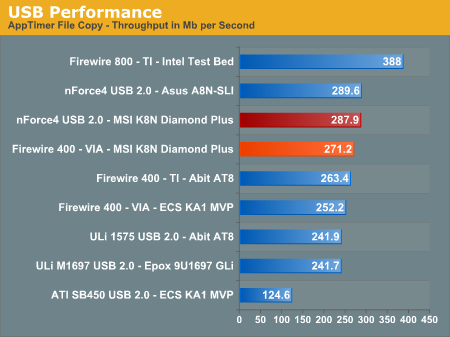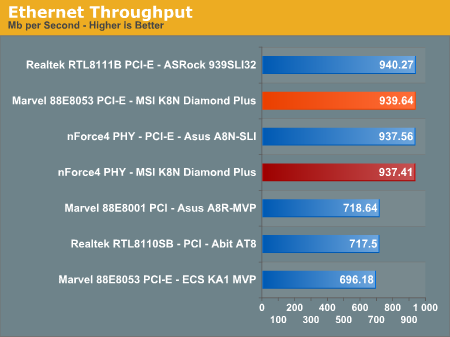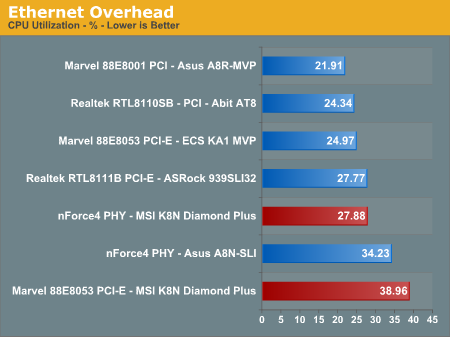Firewire and USB
After looking at many options for Firewire and USB testing, we finally determined that an external USB 2.0, Firewire 400, and Firewire 800 hard disk would be a sensible way to look at USB and Firewire throughput. We utilize a RAM disk as our "server", since memory removes almost all overhead from the serving end. We turn off disk caching on the USB and Firewire side by setting up the drives for "quick disconnect" so our results are consistent.
We use 1GB of fast 2-2-2-5 system memory set up as a 450MB RAM disk and 550MB of system memory. Our standard file is the SPECviewPerf install file, which measures 432,533,504 bytes (412.4961MB). After copying this file to our RAM disk, we measured the time for writing from the RAM disk to our external USB 2.0, Firewire 400, or Firewire 800 drive utilizing our internal Windows based timing program. The copy times in seconds were then converted into Megabits per second (Mb) to provide a convenient means of comparing throughput. Higher Rates therefore mean better performance in this particular test.

The MSI board offers the excellent VIA based IEEE 1394 Firewire option providing better performance than the TI chipset solutions. The USB 2.0 performance is competitive with the other ULi and NVIDIA based controllers in throughput. We did not note any Firewire or USB 2.0 issues with our inventory of peripherals that included steaming data from our USB 2.0 or Firewire 400/800 external storage drive to a USB 2.0 optical drive for backup purposes. Of course, as good as the VIA solution is, it's still a far cry from the performance of Firewire 800. It's surprising that so few companies opt for the faster IEEE 1394B standard, as the price difference can't be very large.
Ethernet Performance
As with recent motherboard reviews, networking performance is measured using the Windows 2000 Driver Development Kit LAN testing utility ntttcp. We set up one machine as the server: an Intel system with an Intel CSA Gigabit LAN connection. Intel CSA has a reputation for providing fast throughput and is a logical choice for our Gigabit LAN server. On the server side, we used the following Command Line:


The NVIDIA nForce4 SLI Southbridge natively supports PCI Gigabit Ethernet operations so the choice of the PCI-E based Marvell 88E8053 10/100/1000Mb/s Ethernet controller as the secondary Gigabit Ethernet controller is an excellent option by MSI.
The performance of the Marvell 88E8053 Gigabit LAN controller is on par with the other boards except for the throughput issue noticed on the ECS implementation of this controller. The Marvell solution provides better throughput than the NVIDIA PHY but at the expense of greater CPU utilization rates. We generally utilized the Marvell controller in our on-line gaming or LAN sessions as it seemed less prone to throughput spikes across our Gigabit network. Although this is a subjective opinion, we are investigating a potential test suite to further look at the extended performance of the network controllers in real world applications.
NVIDIA has tweaked their implementation of ActiveArmor in the latest driver releases by reducing the amount of offloading the ActiveArmor engine provides thereby reducing the amount of hardware based Gigabit Ethernet acceleration. As a result the CPU utilization rates are not as low as before but this was done to avoid data corruption issues that have been dogging NVIDIA since ActiveArmor was introduced. In our testing, we found the driver changes worked as we could not replicate a user based scenario that resulted in data corruption in previous releases. However, we are still testing the driver updates and will provide more information in a future article.
All standard Ethernet tests were performed with standard frames and the NVIDIA ActiveArmor suite disabled unless otherwise noted. Gigabit Ethernet supports Jumbo frames as well and provides a further reduction in CPU overhead.
After looking at many options for Firewire and USB testing, we finally determined that an external USB 2.0, Firewire 400, and Firewire 800 hard disk would be a sensible way to look at USB and Firewire throughput. We utilize a RAM disk as our "server", since memory removes almost all overhead from the serving end. We turn off disk caching on the USB and Firewire side by setting up the drives for "quick disconnect" so our results are consistent.
We use 1GB of fast 2-2-2-5 system memory set up as a 450MB RAM disk and 550MB of system memory. Our standard file is the SPECviewPerf install file, which measures 432,533,504 bytes (412.4961MB). After copying this file to our RAM disk, we measured the time for writing from the RAM disk to our external USB 2.0, Firewire 400, or Firewire 800 drive utilizing our internal Windows based timing program. The copy times in seconds were then converted into Megabits per second (Mb) to provide a convenient means of comparing throughput. Higher Rates therefore mean better performance in this particular test.

The MSI board offers the excellent VIA based IEEE 1394 Firewire option providing better performance than the TI chipset solutions. The USB 2.0 performance is competitive with the other ULi and NVIDIA based controllers in throughput. We did not note any Firewire or USB 2.0 issues with our inventory of peripherals that included steaming data from our USB 2.0 or Firewire 400/800 external storage drive to a USB 2.0 optical drive for backup purposes. Of course, as good as the VIA solution is, it's still a far cry from the performance of Firewire 800. It's surprising that so few companies opt for the faster IEEE 1394B standard, as the price difference can't be very large.
Ethernet Performance
As with recent motherboard reviews, networking performance is measured using the Windows 2000 Driver Development Kit LAN testing utility ntttcp. We set up one machine as the server: an Intel system with an Intel CSA Gigabit LAN connection. Intel CSA has a reputation for providing fast throughput and is a logical choice for our Gigabit LAN server. On the server side, we used the following Command Line:
ntttcpr -m 4,0,‹server IP› -a 4 -l 256000 -n 30000
On the client side (the motherboard under test), we used the following Command Line:ntttcps -m 4,0,‹client IP› -a 4 -l 256000 -n 30000
At the conclusion of the test, we captured the throughput and CPU utilization figures from the client screen.

The NVIDIA nForce4 SLI Southbridge natively supports PCI Gigabit Ethernet operations so the choice of the PCI-E based Marvell 88E8053 10/100/1000Mb/s Ethernet controller as the secondary Gigabit Ethernet controller is an excellent option by MSI.
The performance of the Marvell 88E8053 Gigabit LAN controller is on par with the other boards except for the throughput issue noticed on the ECS implementation of this controller. The Marvell solution provides better throughput than the NVIDIA PHY but at the expense of greater CPU utilization rates. We generally utilized the Marvell controller in our on-line gaming or LAN sessions as it seemed less prone to throughput spikes across our Gigabit network. Although this is a subjective opinion, we are investigating a potential test suite to further look at the extended performance of the network controllers in real world applications.
NVIDIA has tweaked their implementation of ActiveArmor in the latest driver releases by reducing the amount of offloading the ActiveArmor engine provides thereby reducing the amount of hardware based Gigabit Ethernet acceleration. As a result the CPU utilization rates are not as low as before but this was done to avoid data corruption issues that have been dogging NVIDIA since ActiveArmor was introduced. In our testing, we found the driver changes worked as we could not replicate a user based scenario that resulted in data corruption in previous releases. However, we are still testing the driver updates and will provide more information in a future article.
All standard Ethernet tests were performed with standard frames and the NVIDIA ActiveArmor suite disabled unless otherwise noted. Gigabit Ethernet supports Jumbo frames as well and provides a further reduction in CPU overhead.










42 Comments
View All Comments
LoneWolf15 - Tuesday, April 11, 2006 - link
There are TV tuner cards based on ATI's Theater 550 chip, Powercolor makes one, details can be found here:http://www.powercolor.com/product_series_Theater.h...">http://www.powercolor.com/product_series_Theater.h...
Gary Key - Tuesday, April 11, 2006 - link
We are currently reviewing the Powercolor T55E-P03 for an upcoming HTPC article. I think the results against the PCI cards will be interesting. ;-)LoneWolf15 - Wednesday, April 12, 2006 - link
From what I've heard, there's little or no difference in performance. However, the Powercolor would be the card I'd consider for future-proofness.My only disappointment is it doesn't use ATI's Remote Wonder line of remote controls; they include an iR remote of their own choosing instead of the ATI RF model, IIRC.
nullpointerus - Tuesday, April 11, 2006 - link
Interesting, how? Better, worse, wierd, or just unspecified in a frustratingly vague kind of way? ;-)Gary Key - Wednesday, April 12, 2006 - link
Actual throughput was different than the PCI based card, not trying to be vague but I think the article we are putting together will explain it best, new benchmarks, software versus hardware, TV Tuners- single, dual, SD, and HD, single core CPU , dual core CPU, AMD, Intel, NVIDIA, ATI, MCE2005, Linux, PCI, PCI-E, USB, you know just the basics. ;-)
nullpointerus - Wednesday, April 12, 2006 - link
Cool, thanks. I'm looking forward to reading it.ceefka - Tuesday, April 11, 2006 - link
I don't quite get this one. I can imagine it would say something like 1394b can be had on a s939 Gigabyte board for less than $ 100,00 e.g. GA-K8NF9 Ultra. It seems Gigabyte is the only one with 1394b for s939.
Fact is though that there are few F800 devices out there. If you do have one of these, your mobo options are limited.
JarredWalton - Tuesday, April 11, 2006 - link
It should have been "can't be very large" of course. I'm a bit befuddled on how that slipped in there, because I know I corrected that once before. Must have accidentally pasted over the original text at some point.... Ah, well - fixed now regardless.Myrandex - Tuesday, April 11, 2006 - link
I agree too, there is no reason for manufacturer's to not include this. Firewire B devices will not be mass produced without the users with Firewire B ports. I have a Giga-byte s939 SLI mobo with Firewire B on there and I do want to purchase an external enclosure that supports the standard (along with A and USB), but I also wish we would get some highly OCable boards from the likes of Asus or Abit etc. that provides this feature for the future. And also I believe the article is wrong about the price difference being very large, or else you wouldn't see Giga-byte squeezing these into ~$100 boards with other manufacturer's at the same price point including only A (or no firewire at all).Jason
Duplex - Friday, April 14, 2006 - link
1394B to the people!!! Couldn't agree more!--
I also must give credit to MSI for including a parallel and serial port.
There aren't that many people with a printerserver or USB-printer at home (I think).